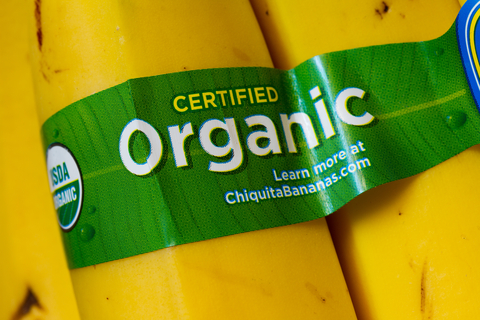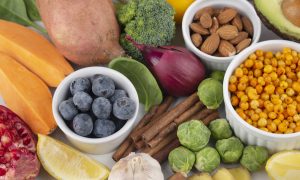By Emily C. Harrison MS, RD, LD.
www.dancernutrition.com.
Food labels today might boast that their product is organic, natural or free-range. Some of these terms have clear standards in the United States and some are just pure marketing statements with no legal definition. As dancers, we need to know what we are fueling our bodies with and make wise nutritional choices. Here Dance Informa takes a closer look at several common food terms and how they are defined.
Each country has its own definitions for food terms, so if you are outside of the US, check with your local dietetic association for local laws or see below for more resources.
Organic
Eating a diet high in fruits and vegetables is pivotal to your health, but buying organic fruit and veggies can cost more, so is it really necessary? My answer is a definitive ‘yes’, both for your health and for the environment! According to the President’s Cancer Panel Report 2010, EPA approved pesticides and herbicides contain nearly 900 active ingredients, many of which are toxic1. There is strong evidence to suggest that these chemicals are linked to cancer, and to recommend that consumers choose food grown without these pesticides or chemical fertilizers1. Children and young people are at higher risk because they weigh less, so their exposure level is higher per pound of body weight. There is compelling evidence suggesting that even low levels of pesticides such as organophosphate insecticides can be linked to lower IQ and developmental problems in children2. The good news is that a study from Emory University, GA, found that eating organic foods can reduce the detectable levels of pesticides in the urine in just 5 days4. It is pretty clear that organic farming methods are much better for the environment. Not only are pesticides implicated in bee colony collapse disorder5, but excess nitrogen from fertilizers contaminate soil and groundwater and can do serious damage to ecosystems2.
Some studies show that organic fruits and veggies have higher levels of healthy phytonutrients and vitamins, but some show that there is not much different in the vitamin content of organic verses conventionally grown. While they may or may not have more vitamins, they do have fewer pesticides 2.
How “organic” is defined
When referring to crops, the word “organic” is legally defined by the United States Department of Agriculture (USDA) as crops being grown with no synthetic pesticides or fertilizers, not irradiated, not genetically engineered, and no sewage sludge. Organic meats cannot contain growth hormones, antibiotics, or other drugs, must be raised on 100% organic feed, and cannot be fed animal byproducts2,6. “Organic” is also defined as using farming methods that work to enhance biodiversity, encourage soil health, and minimize pollution6. The USDA is in charge of policing organic farms and they do their best to try to make sure these strict standards are met.
Ways to minimize costs when buying organic foods
Making your own food and preparing your own fruits and veggies will dramatically cut down on cost, and will make eating organically on a dancer’s budget feasible. Buy organic grains, oats, beans, and snacks in bulk to further cut costs. Cut down on your consumption of meat and dairy, even if it is organic. Eat local! Many cities have food co-operatives that provide bulk bins or group buying from local sources. Check out “Local Harvest” for info in your neck of the woods .
Natural, Fresh, Chemical Free
The word “natural” can be found on pretty much any and every food package these days, even Cheetos. Yes, those fluorescent orange snacks can legally have the word “natural” on the package! This word is only legally defined when it comes to meat, chicken, or eggs. When you see it on chips or cookies, it doesn’t really mean anything. Natural meats cannot contain any artificial ingredients or food coloring, and they must be minimally processed7. The term “Chemical Free” is not allowed to be used on food packaging. “Fresh” is also only defined with chicken and basically means it wasn’t frozen. So beware of clever marketing. Many packages have pastoral images of a farm or garden and use the word “natural” to make you think you are getting something that is healthy, but this might not be the case. Check the food ingredient label. Are the ingredients recognizable? If it sounds like a science experiment, then you might reconsider spending your hard earned money on it.
Free Range
“Free-Range” is also a somewhat vague term. To use this term legally, the chickens must have access to the outdoors at some point7. For some well run farms, this means that they actually do range outside scratching and pecking in the dirt for bugs or worms. However, for other large enterprises this might mean only a small door to a very small yard next to an otherwise large, dark, overcrowded chicken house. Or that door might be open for only a small amount of time during the chicken’s life. Buying eggs from a farmer’s market might allow you to actually meet the farmer and talk to them about their chicken coop conditions.
Hopefully this helps clear up any confusion about food labeling terms. See below for resources and additional reading. Stay tuned for a future article on the well-used terms “low-fat, low sugar and fat free” and what those really mean.
Emily Harrison
 Emily Cook Harrison MS, RD, LD
Emily Cook Harrison MS, RD, LD
Emily is a registered dietitian and holds both a bachelor’s and master’s degree in nutrition from Georgia State University. Her master’s thesis research was on elite level ballet dancers and nutrition and she has experience providing nutrition services for weight management, sports nutrition, disordered eating, disease prevention, and food allergies. Emily was a professional dancer for eleven years with the Atlanta Ballet and several other companies. She is a dance educator and the mother of two young children. She now runs the Centre for Dance Nutrition and Healthy Lifestyles. She can be reached at emily@dancernutrition.com www.dancernutrition.com
Resources for further information:
www.localharvest.org
Nutrition Action Health Letter. Center for Science in the Public Interest. October 2012.
The Environmental Working Group’s 2012 Shoppers Guide to Pesticides in Produce. www.ewg.org/foodnews
Pollan, Michael. The Omnivore’s Dilemma, 2006.
Sources:
1. The President’s Cancer Panel Report 2010: http://deainfo.nci.nih.gov/advisory/pcp/annualreports/pcp08-09rpt/pcp_report_08-09_508.pdf
2. Center for Science in the Public Interest. Nutrition Action. October 2012; pg 2-5.
4. Environ. Health Perspect. 116:537, 2008.
5. Feldscher K. Harvard Gazette: Harvard Science. Pesticide Tied to Bee Colony Collapse. 2012. http://news.harvard.edu/gazette/story/2012/04/pesticide-tied-to-bee-colony-collapse/
6. USDA: Organic Production/ Organic Food, Information Access Tools. 2012. www.nal.usda.gov/afsic/pubs/ofp/ofp.shtml
7. Food Safety and Inspection Service, USDA. 2012. www.fsis.usda.gov/FACTSheets/Meat_&_Poultry_Labeling_Terms/index.asp#14
Photo: © Brad Calkins | Dreamstime.com















